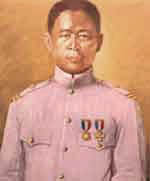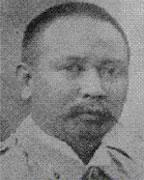1719 - Spanish colonial Gov.-Gen. Fernando de Bustamante y Bustillo is murdered in his palace by a mob led by crucifix-carrying Jesuit friars in the Philippines; Bustamante had earlier introduced reforms after discovering great irregularities in fund management of the royal treasury, a move that angered high officials who were provided refuge by the friars; the murders of de Bustamante and his son who came to his defense, as well as the crimes of corruption in royal treasury management, were never punished.
 |
| Apolinario de la Cruz |
|
|
1841 - A police force to quell the Cofradia de San Jose, a religious Catholic brotherhood (which later allowed in women) in the colonial Philippine islands judged as subversive by the abusive Spanish friars, is formed, co-founded by Apolinario de la Cruz (Hermano Pule), a frustrated priest, with thousands of members of the Cofradia eventually meeting a tragic end after a more powerful military force is subsequently called by the Governor-General on prodding of the abusive Spanish friars to suppress the ensuing rebellion of the brotherhood, with dela Cruz and some of his aides eventually getting caught and executed.
 |
| Crispulo M. Zamora, silversmith |
1922 - Crispulo M. Zamora, an eminent Filipino engraver and silversmith that made insignia for Gen. Emilio Aguinaldo's government, dies at the age of 51; Zamora, schooled in the Academia de Dibujo y Pintura and Escuela de Artes y Oficios, managed to transform a small family engraving shop into a burgeoning enterprise of engraved articles with the help of his wife Pelagia Mendoza, even surviving the Philippine Revolution against Spain and the Philippine-American War (1899-1914).
1899 - The imperialist invading Americans capture San Isidro, Nueva Ecija eight months into the bloody and protracted Filipino-American War; Gen. Emilio Aguinaldo of the fledgling Philippine Republic transfers the capital from Malolos, Bulacan to Tarlac while on the run from pursuing enemy United States forces.
1900 - Gen. Mariano Trias meets with the Japanese Consul regarding a possible Philippines-Japan bilateral cooperation, one year and eight months into the Philippine-American War (1899-1914); the Consul says that Japan desires a coaling station and freedom to trade and build railways in the Philippines but unfortunately, in only about seven months' time, Gen. Trias will surrender to the imperialist enemy Americans soon after the capture and prompt swear of allegiance to the Bald Eagle flag of President Emilio Aguinaldo .
Photo credits: http://www.flickr.com/photos/7716937@N04/page6/
http://www.nhi.gov.ph//index.php?option=com_content&task=view&id=164&Itemid=3


 1919 - Some five or six years after the Filipinos are completely "pacified" by the imperialist Americans, colonial Gov.-Gen. Francis Burton Harrison restores the flying of the Philippine flag through Act No. 2871; the enemy United States authorities had earlier banned the use or unfurling of Filipino flags, including the First Philippine Republic and Katipunan flags, banners, emblems, and symbols through Act No. 1696, also known as the Flag Law of 1907, promulgated past midway into the protracted Filipino-American War (1899-1914); it appears that the most undemocratic and controversial 1907 law banning the use of Philippine flags and symbols was the pale-skinned imperialists' apparent reaction to the defiant and Katipunan-continuation and Katipunan flag-bearing Republic of Katagalugan of Macario Sakay whom the Americans conned into coming down from the hills only to later execute him.
1919 - Some five or six years after the Filipinos are completely "pacified" by the imperialist Americans, colonial Gov.-Gen. Francis Burton Harrison restores the flying of the Philippine flag through Act No. 2871; the enemy United States authorities had earlier banned the use or unfurling of Filipino flags, including the First Philippine Republic and Katipunan flags, banners, emblems, and symbols through Act No. 1696, also known as the Flag Law of 1907, promulgated past midway into the protracted Filipino-American War (1899-1914); it appears that the most undemocratic and controversial 1907 law banning the use of Philippine flags and symbols was the pale-skinned imperialists' apparent reaction to the defiant and Katipunan-continuation and Katipunan flag-bearing Republic of Katagalugan of Macario Sakay whom the Americans conned into coming down from the hills only to later execute him.



 1901 - Imperialist Gen. Jacob H. "Howling" Smith carries out his infamous and most vile and atrocious policy to "Kill every one [Filipinos] over ten" in the province of Samar two years and eight months into the bloody and protracted Philippine-American War (1899-1914); known euphemistically as the "Balanggiga Affair," the wicked campaign is part of United States' revengeful invasion of Samar following the successful attack launched by freedom-fighting townspeople of Balanginga that killed several of the enemy Bald Eagle forces in a surprise attack on a convent house where they were headquartered a month earlier; Smith's burn and kill order that covered all Filipinos who do not surrender did not spare children 10 years of age and will convert the province into a "howling wilderness."
1901 - Imperialist Gen. Jacob H. "Howling" Smith carries out his infamous and most vile and atrocious policy to "Kill every one [Filipinos] over ten" in the province of Samar two years and eight months into the bloody and protracted Philippine-American War (1899-1914); known euphemistically as the "Balanggiga Affair," the wicked campaign is part of United States' revengeful invasion of Samar following the successful attack launched by freedom-fighting townspeople of Balanginga that killed several of the enemy Bald Eagle forces in a surprise attack on a convent house where they were headquartered a month earlier; Smith's burn and kill order that covered all Filipinos who do not surrender did not spare children 10 years of age and will convert the province into a "howling wilderness."





 1950 - The Philippine Politburo, the secretariat of the Central Committee of the Partido Komunista ng Pilipinas (PKP), is smashed as 23 of its top leaders are arrested in Manila, including including General Secretary Jose Lava, during the presidency of Elpidio R. Quirino; the PKP, a pro-Soviet communisty party established on November 7, 1930 that merged with the Socialist Party in 1938 and created the Hukbalahap armed faction that struggled against the Japanese during World War II, would be met by the repression from the imperialist United States and its wealthy, co-opted elites during the post-War period following its increasing influence amidst its agenda of struggling for national independence.
1950 - The Philippine Politburo, the secretariat of the Central Committee of the Partido Komunista ng Pilipinas (PKP), is smashed as 23 of its top leaders are arrested in Manila, including including General Secretary Jose Lava, during the presidency of Elpidio R. Quirino; the PKP, a pro-Soviet communisty party established on November 7, 1930 that merged with the Socialist Party in 1938 and created the Hukbalahap armed faction that struggled against the Japanese during World War II, would be met by the repression from the imperialist United States and its wealthy, co-opted elites during the post-War period following its increasing influence amidst its agenda of struggling for national independence. 







 1938 - Isabelo de los Reyes, historian, anti-friar agitator, newspaperman, labor leader, politician, and co-founder of the Philippine Independent Church during the Spanish colonial rule, dies at age the ripe old age of 74; a lawyer who turned into journalism, de los Reyes' first article was the "Invasion of Limahong" that appeared in Diario de Manila in November 1882 but he would be most controversial for his stirring and pungent anti-friar articles, including the "Sensecional Memoria" which he wrote while imprisoned for supposed complicity in the Philippine Revolution of 1896 and where he blames friars' abuses as responsible for sowing the seeds of rebellion against Spain; de los Reyes would be would later be released and even be appointed Consejo del Ministerio de Ultramar in the Spanish Cabinet from 1898-1901, before being named President of the Republic of the Philippines by some generals following Gen. Emilio Aguinaldo's arrest and swear of allegiance to the imperialist invading United States flag during the early phase of protracted Filipino-American War (1899-1914).
1938 - Isabelo de los Reyes, historian, anti-friar agitator, newspaperman, labor leader, politician, and co-founder of the Philippine Independent Church during the Spanish colonial rule, dies at age the ripe old age of 74; a lawyer who turned into journalism, de los Reyes' first article was the "Invasion of Limahong" that appeared in Diario de Manila in November 1882 but he would be most controversial for his stirring and pungent anti-friar articles, including the "Sensecional Memoria" which he wrote while imprisoned for supposed complicity in the Philippine Revolution of 1896 and where he blames friars' abuses as responsible for sowing the seeds of rebellion against Spain; de los Reyes would be would later be released and even be appointed Consejo del Ministerio de Ultramar in the Spanish Cabinet from 1898-1901, before being named President of the Republic of the Philippines by some generals following Gen. Emilio Aguinaldo's arrest and swear of allegiance to the imperialist invading United States flag during the early phase of protracted Filipino-American War (1899-1914).




